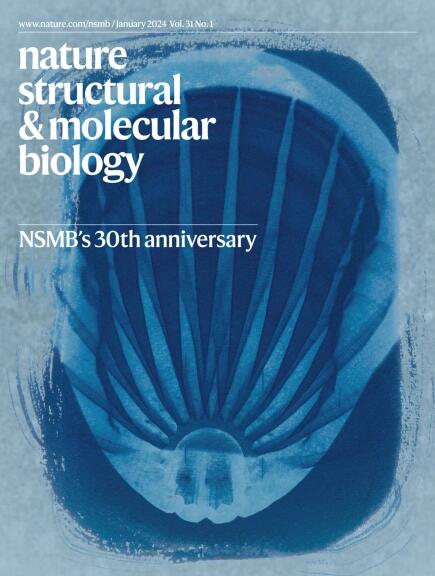The molecular basis of lamin-specific chromatin interactions
IF 10.1
1区 生物学
Q1 BIOCHEMISTRY & MOLECULAR BIOLOGY
引用次数: 0
Abstract
In the cell nucleus, chromatin is anchored to the nuclear lamina, a network of lamin filaments and binding proteins that underly the inner nuclear membrane. The nuclear lamina is involved in chromatin organization through the interaction of lamina-associated domains within the densely packed heterochromatin regions. Using cryo-focused ion beam milling in conjunction with cryo-electron tomography, we analyzed the distribution of nucleosomes at the lamin–chromatin interface at the nanometer scale. Depletion of lamins A and C reduced nucleosome concentration at the nuclear periphery, while B-type lamin depletion contributed to nucleosome density in proximity to the lamina but not further away. We then investigated whether specific lamins can mediate direct interactions with chromatin. Using cryo-electron microscopy, we identified a specific binding motif of the lamin A tail domain that interacts with nucleosomes, distinguishing it from the other lamin isoforms. Furthermore, we examined chromatin structure dynamics using a genome-wide analysis that revealed lamin-dependent macroscopic-scale alterations in gene expression and chromatin remodeling. Our findings provide detailed insights into the dynamic and structural interplay between lamin isoforms and chromatin, molecular interactions that shape chromatin architecture and epigenetic regulation. Wang, Kronenberg-Tenga, Rosti and colleagues use several structural approaches to analyze the distribution of nucleosomes at the lamin–chromatin interface, test the impact of lamins on nucleosome density and identify a lamin A nucleosome-binding motif.

核纤层蛋白特异性染色质相互作用的分子基础
在细胞核中,染色质被固定在核层上,核层是由核层丝和核膜下的结合蛋白组成的网络。核层通过密集排列的异染色质区域内层相关结构域的相互作用参与染色质组织。利用低温聚焦离子束铣削结合低温电子断层扫描,我们在纳米尺度上分析了核小体在核层蛋白-染色质界面上的分布。层粘连蛋白A和C的缺失降低了核周围核小体的浓度,而b型层粘连蛋白的缺失导致了核小体靠近层的密度,而不是更远的核小体密度。然后我们研究了特定的层蛋白是否可以介导与染色质的直接相互作用。利用低温电子显微镜,我们鉴定了与核小体相互作用的层状蛋白a尾部区域的特定结合基序,将其与其他层状蛋白同工型区分开来。此外,我们使用全基因组分析检查了染色质结构动力学,揭示了基因表达和染色质重塑中蛋白依赖的宏观尺度变化。我们的研究结果为层状蛋白同工型和染色质之间的动态和结构相互作用、形成染色质结构和表观遗传调控的分子相互作用提供了详细的见解。
本文章由计算机程序翻译,如有差异,请以英文原文为准。
求助全文
约1分钟内获得全文
求助全文
来源期刊

Nature Structural & Molecular Biology
BIOCHEMISTRY & MOLECULAR BIOLOGY-BIOPHYSICS
CiteScore
22.00
自引率
1.80%
发文量
160
审稿时长
3-8 weeks
期刊介绍:
Nature Structural & Molecular Biology is a comprehensive platform that combines structural and molecular research. Our journal focuses on exploring the functional and mechanistic aspects of biological processes, emphasizing how molecular components collaborate to achieve a particular function. While structural data can shed light on these insights, our publication does not require them as a prerequisite.
 求助内容:
求助内容: 应助结果提醒方式:
应助结果提醒方式:


